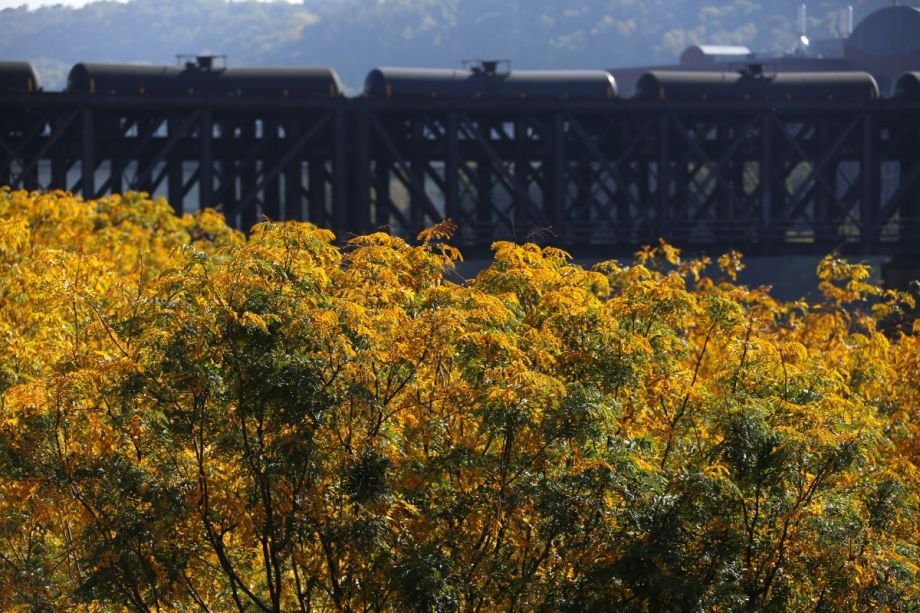In Pittsburgh, a vacant five-acre plot along the Allegheny River will soon be helping to build cities once more.
The land — which sits directly under the 62nd Street Bridge — is the former location of the Tippins, Inc. steel mill. After the company declared bankruptcy in 2009, going the way of many former steel companies in the area, the land sat empty.
But today, that land is on its way to becoming a key venue for renewed efforts to restore and maintain urban forests across the U.S. Construction is moving ahead at the site on a low-slung glassy building designed to achieve LEED Platinum and net-zero energy certifications. Nearby will be two nurseries large enough to accommodate 100,000 seedlings. It will open this summer as the riverfront campus and education center for Tree Pittsburgh, a nonprofit founded in 2006 out of citizen concern for the health of the city’s urban forest.
Earlier this year, Tree Pittsburgh released a study that found Allegheny County experienced a tree canopy loss of 10,148 acres between 2010 and 2015.
“We had some guesses — we knew there would be some decline,” says Danielle Crumrine, Tree Pittsburgh executive director. “But we were pretty shocked when we actually saw the results.”
The team expected some reasons for tree loss, such as insect invaders like the emerald ash borer or diseases such as oak wilt. But those factors accounted for only 1 percent of loss, Crumrine says. The greatest impact actually came from housing, road, utility and rail expansion, as well as gas drilling and pipeline development.
Cities across the country are facing similar losses in urban tree cover. This month, a study by the Forest Service found that tree cover in urban areas has declined at a rate of around 175,000 acres per year from 2009 to 2014 — corresponding roughly to 36 million trees lost per year — while an estimated 40 percent of new impervious surfaces (mostly roads and buildings) replaced areas where trees used to grow.
Trees are essential to the health of any city, explains David Nowak, co-author of the study. “People understand the tangible benefits — aesthetics, wildlife, and air temperatures,” he says. Not only do trees cool the temperature of cities, they mitigate rainfall runoff and combat climate change by taking carbon out of the atmosphere. The study estimates the loss of these benefits — including carbon storage, pollution reduction and altered energy use in buildings — at $96 million a year.
“If we go down the trend of having all development and no trees, there’s a huge cost associated with that,” says Nowak. “Each community has to … realize they’re losing canopy cover and decide what they want to do about that.”
In Pittsburgh, that means a multi-pronged approach that includes outreach between different municipalities to devise planting plans, technical support to aid “community watchdogs for trees,” Crumrine says, and outreach like tree-tender trainings and free tree distribution events.
In New York City, the Natural Areas Conservancy and the NYC Department of Parks and Recreation unveiled a comprehensive plan to bolster and protect the city’s urban forests.
New York City boasts 43 types of forests over 7,300 acres. Nowak notes that cities often have more diverse forests than actual forests, because “we have a natural seed source from the forests originally there, then we bring plants in from Europe, Asia, and we plant other trees.”
The comprehensive plan process found NYC forests in surprisingly good condition, with 85 percent dominated by healthy native trees. But the next generation are less healthy, particularly due to challenges from invasive species. Development is less of a threat, says Sarah Charlop-Powers, executive director and co-founder of the Natural Areas Conservancy, because “the land use patterns as it relates to open space are somewhat set.”
The plan calls for a combined public and private commitment of $385 million over 25 years to fund forest monitoring, restoration, planting, management and long-term maintenance. Some of the proposed funding would go to nonprofits, such as the Prospect Park Alliance, in Brooklyn, and the Forest Park Trust, in Queens, for forest enhancement efforts.
Prospect Park boasts 250 acres of woodlands the park began restoring in the 1990s. “A focus on the transformation of the park was focusing on the woodlands and getting people back into the woodlands,” says Susan Donoghue, the alliance’s president. “People didn’t feel comfortable really going into the inner part of the park in the late ‘80s and early ‘90s.”
Today it’s a well-trafficked space; the Natural Areas Conservancy found that “about 60 percent of [New Yorkers] we interviewed reported spending time in natural forests,” says Charlop-Powers.
Prospect Park Alliance continues to focus on outreach, hosting large-scale volunteer planting days. “That early stewardship is one of the best ways, especially in an urban environment, to have a real association with trees,” Donoghue says.
Tallahassee is another city taking a proactive approach to its urban tree canopy. Last year the city allocated $125,000 for an urban forestry master plan which is now in the works.
“This is a growing city, with more development pressure, so maintaining the tree canopy while the city was developing became more and more important,” says Mindy Mohrman, of the Tallahassee-Leon County Planning Department.
The master plan will measure the current state of Tallahassee’s urban forests, which the city previously hadn’t monitored closely. By getting that data, Mohrman says, the city will be able to understand how to best maintain and grow its forests, from targeting invasive species to planting more wind and storm-resistant trees.
Luckily, Mohrman says, the master plan won’t be needed to convince people of the benefit of trees — Tallahassee has a longstanding designation as a Tree City USA from the Arbor Day Foundation. “People here really appreciate the trees,” she says. “Their fear is that developers don’t, and the city needs to make sure they’re required to preserve and replant.”
This article is part of The Power of Parks, a series exploring how parks and recreation facilities and services can help cities achieve their goals in wellness, conservation and social equity. The Power of Parks is supported by a grant from the National Recreation and Park Association.

Emily Nonko is a social justice and solutions-oriented reporter based in Brooklyn, New York. She covers a range of topics for Next City, including arts and culture, housing, movement building and transit.
Follow Emily .(JavaScript must be enabled to view this email address)







_600_350_80_s_c1.JPEG)








